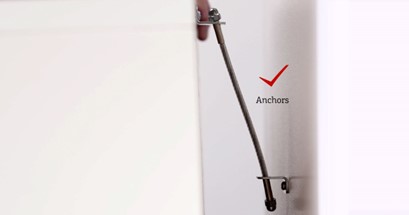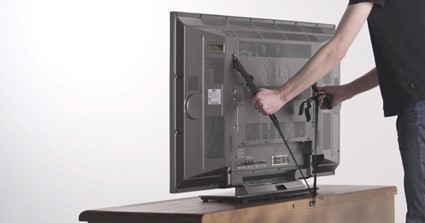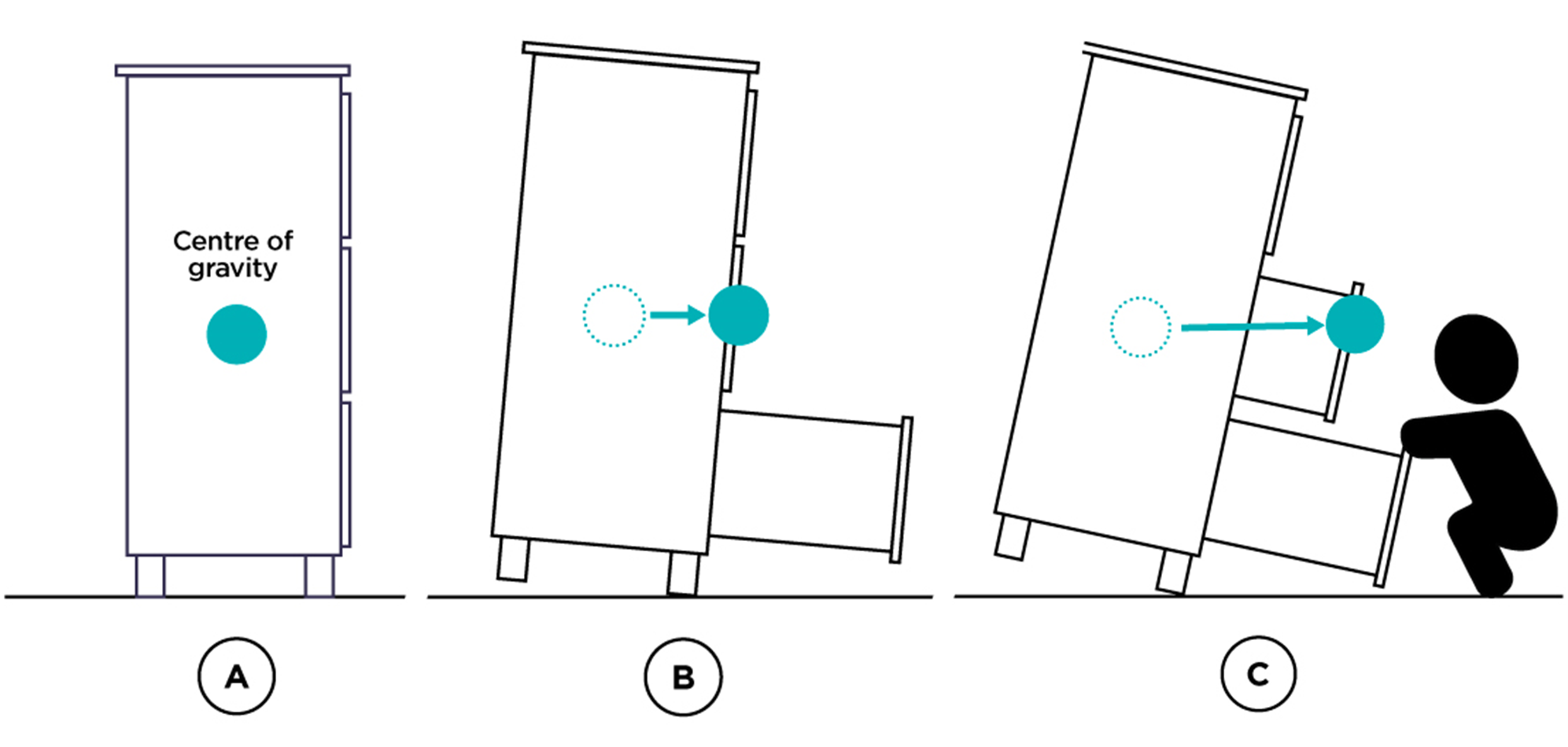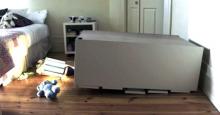About toppling furniture and televisions
Freestanding household furniture can be dangerous if it falls or topples over. This type of furniture includes:
- bookcases
- chests of drawers and wardrobes
- cabinets
- entertainment units
- unsecured televisions
- hall tables, buffets and sideboards.
Things to look for when buying the product
Serious injuries and deaths have happened when furniture or TVs have fallen onto children and adults. For this reason, there’s a mandatory information standard that suppliers and retailers must comply with.
Think about safety when you’re buying furniture and TVs, especially if you have young children in your home or who might visit. When you’re out shopping, use these tips to help you choose safer furniture.
- Examine the furniture to make sure it is stable.
- Pull out any top drawers of a chest of drawers or open doors on other furniture items and apply a little pressure to see how stable the furniture is.
- Make sure the drawers don’t fall out easily.
- Look for built in drawer stops that limit how far drawers can be extended or interlocks that prevent more than one drawer being opened at a time.
- Look for furniture with sturdy backing material which increases stability.
- Look for low-set furniture, or furniture with a sturdy, stable and broad base. It’s less likely to tip over.
- Look for furniture that comes with safety information or equipment to anchor it to the wall. If it doesn’t, you can buy an anchoring kit. Ask a staff member if you need help to choose the right product for your home.
- Plan your purchase. Think about where the furniture will go. Can you anchor your furniture to the wall or floor?
How to use the product safely
Where to put furniture
Place furniture on a flat, even surface where possible. Furniture is more unstable when placed on an uneven or soft surface, such as carpet or a rug.
If you plan to place your furniture on carpet against a wall, check to make sure the carpet isn’t bulging. Sometimes, carpet can become thicker and more uneven at the wall’s edge, and this can make furniture less stable.
Secure furniture

The best way to prevent furniture from tipping over is to secure it to the wall or floor.
If your furniture doesn’t come with anchoring hardware you can buy what you need from a furniture retailer, hardware store or a specialty store for baby goods. You can also do this if you’re securing furniture you’ve had for a while, or bought second-hand.
What you’ll need depends on what your wall or floor is made of, and what kind of furniture you’re working with. There are different kinds of wall and floor anchors available.
If you’re not sure, ask for advice at your local hardware shop, or ask a tradesperson.
Secure your TV

Most TVs come with anchor straps. You can use them to attach your TV to the wall or to another piece of furniture, like a TV stand or entertainment unit.
Choose a spot for your TV that’s stable and low to the ground. Don’t put TVs on furniture that isn’t intended for this purpose, such as a chest of drawers.
If you secure the TV to a piece of furniture, make sure the furniture is also secured to the wall.
Consider wall-mounting your TV.
Keep your children safe
Young children don’t understand the risks, but they are the most likely to be hurt or killed by toppling furniture or TVs.
As well as securing your furniture and TVs, here are some things you can do to help keep them safe.
- Keep your heaviest items at the bottom of your drawers or shelves. Furniture that is top-heavy is easier to tip over.
- Don’t place heavy items such as TVs or items that are attractive to children on top of furniture.
- Put locking devices on all drawers. They help prevent children from opening them and using them as steps.
Advice for tenants
If you’re renting a home, talk to your landlord or agent about installing anchor devices to the wall. Explain why you want to secure your furniture and let them know you’ll remove them at the end of your tenancy.
In Western Australia, New South Wales and Victoria, there are laws that make it much easier for tenants to secure furniture to the wall for safety reasons.
For more information visit:
If you’re in another state or territory visit:
- ACT — Tenancy Advice Service
- SA — Consumer and Business Services
- QLD — Residential Tenancies Authority
- NT — Consumer Affairs
- TAS — Consumer, Building and Occupational Services
Risks and injuries from the product
Toppling furniture has killed at least 28 people in Australia since 2000 and causes nearly 20 injuries every week.
Children under 5 years old are most at risk of serious harm from toppling furniture or TVs.
Toppling furniture can hit, trap or crush someone underneath resulting in:
- broken or dislocated bones
- head and brain injuries
- crush injuries
- suffocation
- asphyxiation (loss of oxygen).
Heavy items, such as TVs, placed on top of furniture may fall when furniture becomes unstable, contributing to the severity of injuries.
Although modern TVs are much thinner and lighter when compared to older models, they can still cause serious injuries or death if they topple onto small children.
Opening drawers or doors shifts the weight of the unit forward and the additional weight of a child further increases the risk of toppling.

Blake’s story
In August of 2016, Blake Shaw was killed when a freestanding bookshelf tipped over and fell on him. He was just 3 years old. His mum and dad, Kirstie and Tim, have bravely shared Blake’s story with us. They want to help raise awareness of the risks of toppling furniture.
KIRSTIE SHAW: Our Blakey was one of a kind that's for sure. He came into this world a bit early at 36 weeks. He was very particular in everything that he did. He had things a certain way and you couldn't touch it.
TIM SHAW: He'd be happy to walk off into another room and play with his cars on the car mat. Just lying down just shaking his legs back and forth for hours on end. He was just
KIRSTIE SHAW: He was just perfect
NEWS READER: The parents of a three-year-old boy are trying to comprehend how their son was killed by a bookcase in a tragic accident at the family's home in rural Victoria. Now we understand that the bookshelf itself or the cabinet was quite heavy it wasn't secured but it was pushed up against a corner.
KIRSTIE SHAW: And then we just heard Adam yell 'help'
TIM SHAW: crash
KIRSTIE SHAW: Crash and bang and the cabinet was down.
TIM SHAW: Got the cabinet up to the top and he was just right in the bottom corner just curled up. He was gone by then.
WARWICK TEAGUE: The sad truth is every year one or two children like Blake will die from injuries from toppling furniture or televisions. Particularly injuries here are in children that are about one or two years of age. Sometimes as young as six months of age and they have mostly sustained injuries to their head. This could be fractures of the skull it could be injury to the brain itself or bleeds on or around the brain and these are injuries with potential long-term even life-threatening consequences.
MELANIE COURTNEY: Children are naturally inquisitive and will not always use furniture as its intended. That's why we need to ensure that their environments are as safe as possible. So most furniture is now sold with either a fastener or an anchor that you can use. If not you can purchase these from your local hardware or baby store. It's really important to take that extra few minutes when you're assembling furniture to make sure that you have secured it as per the manufacturer's instructions.
WARWICK TEAGUE: There's no wall and there's no piece of furniture that's more precious and more beautiful than your child. There's no agreement that we have or commitment that we make that is more important or more valid than the commitment we make to our children to protect them from injury.
VOICE OVER: There are further measures you can take to prevent furniture tip overs. Place locking devices on drawers to prevent children from opening them and using them as steps. Remove any items from the top of furniture that children may try to access such as toys, TV remotes and lollies. Remove any heavy items from the top of furniture such as vases and ornaments as this can cause furniture to become unstable.
KIRSTIE SHAW: It's not something you think about it's you know 'oh yep' or 'I'll do it later' or but you don't think about it until you see it happen or you know someone close to you that happens.
VOICE OVER: Don't wait for tragedy to strike. Anchors are available at hardware stores and at many furniture and television retail outlets. Make it a priority today. Visit the ACCC Product Safety Australia website or contact your state or territory Consumer Protection Agency for more information
Next steps if a product is unsafe
When buying a product, consumers have the right to expect the product is of acceptable quality. Acceptable quality means the product is safe, durable and free from defects.
From 4 May 2025, certain furniture products must comply with the Consumer Goods (Toppling Furniture) Information Standard 2024. This means suppliers must:
- attach permanent warning labels to furniture
- display point of sale warnings, both instore and online
- include information about the risk of toppling furniture in any instruction manuals provided with the furniture.
View further information about the toppling furniture mandatory information standard.
If you bought a product that doesn’t meet the mandatory standard and is unsafe, you can report it.
If a person is seriously injured or needs urgent medical help, call emergency services on triple zero (000).




